Chapter 12
Not Another Winter in the Bahamas
December 1992 and January 1993
We only spent one day in West Palm Beach.
On Monday 7th December the portents looked good: a light south wind predicted to swing to the southwest, so by four in
the afternoon we were under way motoring for Lake Worth Inlet. By five thirty we were out in the Gulf Stream and found
the wind so light we motored for three hours. Later the it picked up a bit and we sailed along at up to six knots, a very
pleasant crossing. At one point we found ourselves in the middle of half a dozen other yachts going the same way, but we
gradually separated again as they were heading for Memory Rock, while we planned to cross onto the banks at Indian Cay
Rock, which we did at seven thirty in the morning. We wanted to make it to Great Sale Cay that evening, another 42 miles,
and so when the wind went light again we started up the motor. An hour later it started to cough and splutter and the
power dropped. A quick check showed the motor was badly overheated, so we shut it down at once. From now on, until I
could get it looked at in Marsh Harbour, we could only use the motor for short periods in case of emergency . With
practically no wind we drifted into the lee of Mangrove Cay (which provides very poor shelter) and twenty three hours
from Palm Beach we dropped anchor. This was the first delay in what was to be our slowest crossing of the Abacos.
During the night we got wind; lots of it. We found ourselves bouncing around in a brisk northerly, swinging slowly to the
northeast; a headwind. By sunrise we were under way, beating to windward and it took us most of the day to make good
twenty five miles over the bottom. By four thirty we were a couple of miles past Little Sale Cay, but it was obvious we
would not make Hawksbill Cay, the next shelter, by dark, so we put back
and anchored in the lee of Little Sale, making sure we were in a good
position to see the total eclipse of the moon which started at sunset.
An island freighter also anchored near the cay that night, and next
morning they put seven men ashore in a dinghy to replace the
navigational light (which hasn't worked in years) with a brand new solar
powered job. Later we were to find that all the minor lights in the Abacos
(marked unreliable in the charts) have been similarly replaced and at
night there is almost always a winking light visible.
The headwinds continued, but they were slowly veering, and a strong
cold front was predicted. This was no place to stay, so as soon as the
wind had veered enough (just before midday) we were on our way, close
hauled for Allens-Pensacola Cay. Before we got there a strong squall with
heavy rain blotted all the cays around us, and necessitated a quick
reduction of sail, but it was over in half an hour, and an hour before
sunset we anchored.
The front and subsequent "norther'' held us down there for two days.
The guide book says that this is not a good harbour in a norther, but with
the shallow draught of a multihull we could go far up the bay and anchor
in patches of clear sand. A shoal draught flat bottomed monohull
weathered it out with us and we were both quite comfortable. Finally on
the 13th December the fine weather returned and we sailed down to
Green Turtle Cay where, the following morning, we officially entered the
Bahamas.
The Sea of Abaco from Allens-Pensacola Cay to Little Harbour is a
beautiful sheltered body of water some 75 miles long and three to five
miles wide between the mainland of Abaco and an almost continuous
string of cays and reefs. The bottom is all sand and has sufficient depth for most yachts except just south of Green Turtle
Cay where it is blocked by sandbars with only a couple of feet of water over them. Here one has to sail out across the reef,
around Whale Cay and back in on the other side. When strong northeasterly weather builds up heavy seas they break right
across Whale Cay Passage and it becomes very dangerous, impassable even by the big inter-island freighters. Sometimes
even in calm weather storms far to the north in the Atlantic can send heavy rollers south to burst across all the reef
passages and close them off. This condition is known locally as a "rage'', a very apt description, and this is the way it was
when we got there. A major winter storm was battering the northeastern U.S.A. and we were feeling the swells down here.
Even a shallow draught boat cannot sneak through on the inside at high tide as it would be smashed against the bottom by
the swells.
We stopped three days near Green Turtle Cay in perfect sailing weather waiting for the swells to die down. Rudi and
Dorothy were also there on the PDQ Catamaran Venus. We had last seen Venus in George Town last spring, since then
Rudi had sailed her up to Canada and back. On the fourth day the swells were down but there was no wind, without our
engine we were stuck for another day. Finally on the 18th a light
breeze sprang up at mid morning and we sailed slowly down to
Marsh Harbour, arriving after dark. Having the lights all working
was a great help.
The passage from Indian Cay Rocks where we had crossed onto the
banks had taken ten days; going the other way last August we had
done it in two. That's what sailing is like.
At Marsh Harbour the Yamaha mechanic did not have time to look
at the engine before the holidays, but he suggested a broken water
pump impeller as the probable cause. The only possible
complication was that a broken vane might be floating about in the
water jacket and block off some internal passage. I bought a new
impeller (I should have carried a spare) and sure enough when I
removed the old one two vanes were missing. I have only found one
of them but until now (and I'm touching wood) the engine has not
overheated again.
We spent Christmas and New Year's at Little Harbour, in fact we
spent a whole month there. Iris did a number of paintings for the gallery (and sold two) while I did some sketching and
some work on Oborea. For the most part the weather was beautiful, much nicer than last winter. Only one norther in the
month and some blustery rain out of the east for a couple of days to put a bit of a damper on Pete's annual New Year's Hog
Roast.
Finally on 17th January the wind switched round to the northwest behind the first cold front in several weeks and we were
off to the beautiful blue Exumas. Rudi had intended to sail south with us, but Dorothy developed an eye problem that
required medical attention so he headed back north toward
Hope Town. The winds grew lighter as we sailed on and we
had to run the engine for the last three hours to make it past
the reef and in to Egg Island before dark, where we
anchored in a little sandy bay on the south side. There was a
McGregor catamaran, Straycat, already anchored there and
the two young men aboard called us over. They had just
caught an 18 lb tuna and with no refrigeration aboard they
could not keep more than they could eat so they gave us
enough to provide dinner for three days! I would never have
considered a McGregor as a long distance cruiser, but Felix
and Josie were on their way to the Dominican Republic.
Here at Egg Island we saw some of the effects of Hurricane
Andrew; the pretty little beach used to be backed by a grove
of high casuarinas, now most of them have been blown
down and those still standing are defoliated with many broken branches like ghosts of trees. The stranded freighter a few
miles south of the island that for years has been a landmark for boats heading for Nassau now looks more like three little
islands of rusty steel than a boat.
We sailed on next day following Straycat to Current Cut. The
tide was against us through the cut and motor sailing at six knots
it took us twenty minutes to get through the half mile! Of the
settlement of The Current only six houses out of thirty to forty
were left standing by the hurricane, but reconstruction is
underway and as we passed the aptly named mail boat Current
Pride was unloading building supplies. Straycat left us here
heading for Hatchet Bay in Eleuthera while we continued
southward to the Exumas where we anchored just before four in
the lee of Ship Channel Cay.
The word for the Exumas this trip seems to be "wind'' and lots of
it. We sailed down the inside channel to Normans Cay where we
stopped in the rather exposed anchorage. Iris collected a good
bag of conch here, but the sea was too rough to ferry out fresh
water from the cistern on shore. Next day we continued on close
hauled under only jib and mizzen. We were still doing up to eight
knots, and west of Big Opening the ride got very rough and wet
so we had to slow down a bit. We were heading for Thomas Cay
in Pipe Creek, a favourite anchorage of ours. In the lee of Rat Cay
we put on the motor and dropped sails for the last mile to
windward when we discovered no water coming out of the cooling tell-tale on the motor. We shut down and anchored
where we were. Further investigation discovered a blockage in the little rubber tube leading to the tell-tale, the engine was
actually cooling alright, but we stayed where we were for the night.
Strong east winds continued the next day and we motored a mile through the incredible turquoise water and white sand of
Pipe Creek to our snug anchorage off Thomas Cay. Later we walked ashore to the windward side of the island to watch the
waves smashing on the white limestone cliffs sending showers of sun sparkled spray far inland. Where the cliffs ended the
wind whistled through the dune grass.
Next morning we motored five miles to the tiny
settlement of Staniel Cay. The anchorage was crowded
with boats waiting out the high winds. (A monohull
from Québec really stood out with its color scheme of
hot pink with magenta trim!) Ashore we saw the frame
of a new Bahamian racing sloop under construction.
From Staniel we covered 24 miles close hauled under
working sail in three and a quarter hours to Rudder Cut
Cay, catching two jack (one a very large one) along the
way. Here we filled all our water tanks at the cistern
and went for a long walk ashore. We were only a day
away from George Town, but the winds were even
stronger and right on the nose. There were gale
warnings for the northern Bahamas, so we motored a
couple of miles to the snug little anchorage between Big
and Little Darby Cays to settle down for a few days
wait. This also seems to be the year for shallow water
conch—at Normans Iris filled our bag in four feet of
water, at Rudder Cut Cay I picked up a huge one from
the dinghy without even getting my feet wet, and at Big
Darby I found two more while wading off the beach!
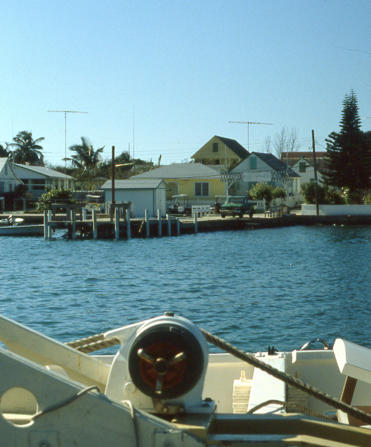
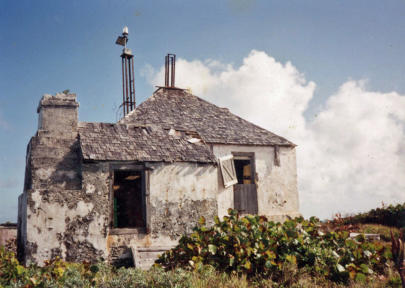
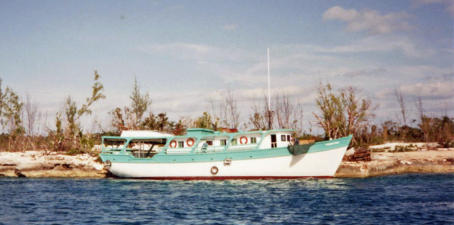
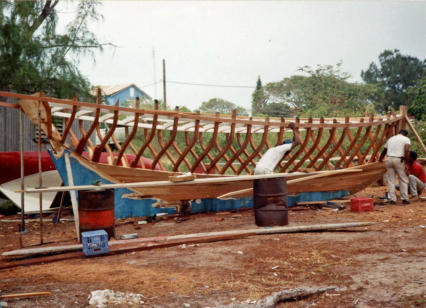
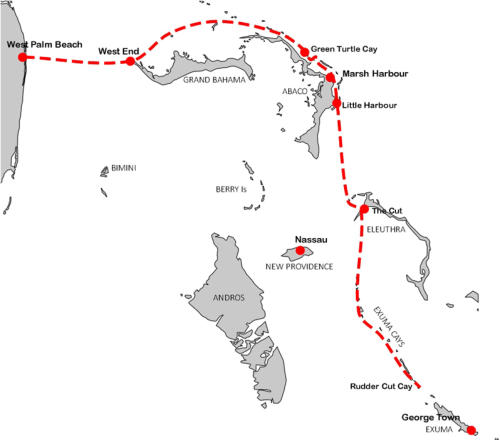
New Providence, Green Turtle Cay
Little Harbour Light
Current Pride
Boatbuilding at Staniel Cay